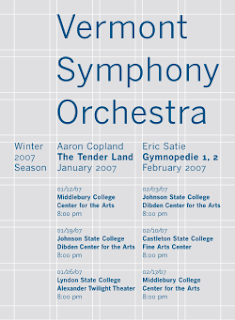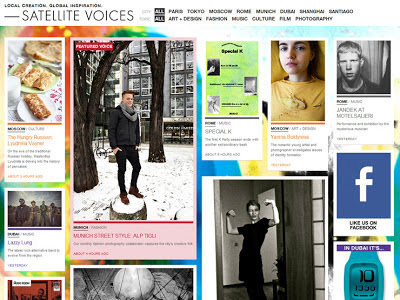“ The grid system is an aid, not a guarantee.
It permits a number of possible uses and each
designer can look for a solution appropriate to his
personal style. But one must learn how to use the
grid; it is an art that requires practice. ”
Josef Müller-Brockmann
What is Grid System?
The grid system in graphic design is a way of organizing content on a page, using any combination of margins, guides, rows and columns. It is commonly seen in newspaper and magazine layout with columns of text and images. One grid, or a collection of grids, may be used across an entire project to achieve a consistent look and feel. In a finished product, the grid is invisible, but following it helps in creating successful print and web layouts.
A grid at its barest is nothing more than a series of intersecting horizontal and vertical lines spaced at regular intervals, but its innate propensity for creating order out of chaos makes it one of the most powerful tools at a designer’s disposal.
 |
| Basic Grid |
 |
| Basic Planing Grid |
Grid Anatomy
Columns
The vertical bands of modules. There can be any number of columns in a grid. More columns leads to more flexibility, but can also make the grid difficult to work with.Column widths can be equal or they can vary across a grid.
Rows
The are the horizontal equivalent of columns. Online it’s harder to plan for rows as the height of the format is often inconsistent and dynamic.On some pages your design may call for a fixed height, though on most pages your design is allowed grow vertically with the content.
Gutters
Are the spaces separating modules either vertically or horizontally. Typically we think of gutters as the space between columns, but they are also the space between rows.The minimum width or height of gutters should be an ‘em’ though this should usually be larger to better separate columns from columns and rows from and rows. The height of horizontal gutters should be based on the leading or line-height of the type.
Folio
Are created when page numbers are placed consistently in the margin, usually above or below the composition.
Running Header or Footer
A running header is a guide at the top to indicate your position in a manuscript. You’d find information like title, chapter title, section title, author, etc located here. A running footer is then this information is placed at the bottom of the format.
Markers
Markers are placement indicators for subordinate or consistently appearing information. Markers can be used to denote the location of folios, page numbers, etc.
 |
| Grid anatomy |
LAYOUT
A layout is a place where you do your design and place text, images, colour, etc. using grid as a guide line.
Gridded layouts represent geometric systems used to create pleasing dimensions in art and architecture. One of the oldest grid systems, the golden section, or golden mean, derives from nature and takes its cue from the early Greeks. It creates rectangles with a length-to-width ratio of approximately 1.62 and provides proportions that can be applied to any design task. Today's graphics software makes it easy to impose order on a layout using mathematical relationships among design elements.
Grid layouts begin with an overall space and subdivide it into vertical geometric units. In a grid with two columns of equal width, all content must be created, cropped or scaled to fit one dimension and placed in one or the other of the two divisions of overall space. Grids made up of multiple narrower columns give you the freedom to define elements that span more than one column in width. Some grids remain purely vertical, whereas other design systems break up page height into grid units as well.
WEB BASE
In the last two years or so, grid-based layouts have become very popular in web design. A grid is a series of intersecting horizontal and vertical lines that serve as guides to place elements in a design. To put it in simple words, grids are a system for creating order among elements in a website.
Grids provide a common graphic language that makes it easier for both designers and developers to work on a website. It helps users to better understand the information as it's shown in a more structured and logical way.
PRINT BASE
A spread layout on grid: an important element in design. The design literally shows the grid lines and guide lines that was used in creating the layout. The base-line grids, margins, columns and gutters became visible design elements on the page instead of just being the invisible underlying structure.
Used in newspapers, magazines , book, clothing product etc. The contrast of text size ,image, color and the position the page creates a predictable of order.
TIME BASE
A grid time base is usually used in video, television on our cell phones, etc. A good design for screen layout should be nocely presented and easy to read for the audience.
Art Work Using the Grid System By Piet Mondrain
He was an important contributor to the De Stijl art movement and group, which was founded by Theo van Doesburg. He evolved a non-representational form which he termed Neo-Plasticism. This consisted of white ground, upon which was painted a grid of vertical and horizontal black lines and the three primary colors
Mondrian began producing grid-based paintings in late 1919, and in 1920, the style for which he came to be renowned began to appear.
In the early paintings of this style the lines delineating the rectangular forms are relatively thin, and they are gray, not black. The lines also tend to fade as they approach the edge of the painting, rather than stopping abruptly. The forms themselves, smaller and more numerous than in later paintings, are filled with primary colors, black, or gray, and nearly all of them are colored; only a few are left white.
Mondrian produced Lozenge Composition With Four Yellow Lines (1933), a simple painting that introduced what for him was a shocking innovation: thick, colored lines instead of black ones. After that one painting, this practice remained dormant in Mondrian's work until he arrived in Manhattan, at which time he began to embrace it with abandon. In some examples of this new direction, such as Composition (1938) / Place de la Concorde (1943), he appears to have taken unfinished black-line paintings from Paris and completed them in New York by adding short perpendicular lines of different colors, running between the longer black lines, or from a black line to the edge of the canvas. The newly-colored areas are thick, almost bridging the gap between lines and forms, and it is startling to see color in a Mondrian painting that is unbounded by black. Other works mix long lines of red amidst the familiar black lines, creating a new sense of depth by the addition of a colored layer on top of the black one.
His painting Broadway Boogie-Woogie (1942–43) at The Museum of Modern Art in Manhattan was highly influential in the school of abstract geometric painting. The piece is made up of a number of shimmering squares of bright color that leap from the canvas, then appear to shimmer, drawing the viewer into those neon lights. In this painting and the unfinished Victory Boogie Woogie (1942–44), Mondrian replaced former solid lines with lines created from small adjoining rectangles of color, created in part by using small pieces of paper tape in various colors.
 |
| Broadway Boogie Woogie |
My Layouts
For this 1 i had visited the Wednesday market that open every week near my university and saw how are the stalls arranged and used that arrangement to make the grid lay out.I divided the stalls and the road and the footpath to get the simple look.
Rough sketch
For the 2nd i used my class room to find a gird layout by dividing the tables, space , door and the walking ares
Rough sketch
MY DESIGN
Well just playing round with grid and having fun...I used the disco ball and thought how could i convert it into a heart shape like... just to show the love for dance.. don't know if i got it right.. so here's the rough sketch.
For my Graphic design assignment is was asked to make a lay out using grid system. I thought of doing something different and use different materials. So I started looking around to get my grid layout, I looked at my class room the way the tables and chair were arranged in a systematic manner or the Wednesday market the way all stalls are arranged. But I wanted something different something that wouldn't look like bunch of squares or rectangles combined together. So I looked at hand and thought of ways to get a grid layout out of it. I used the victory sign to represent peace and thought of ways to divide it into different layers to form a grid. I took one picture as a reference.
 |
| Reference |
Once that was done, i was thinking of using grid system to make and to fill color.. so i just came up with this rough back ground
 |
| Reference |
Using the back ground and over laying the hand sketch i got the basic guide lines i need to fill in color.
I came up with something like this. Just a rough sketch to get the basic idea how i am going to go with this
I stopped with the previous design and thought of doing something different with it. So using the same guide line idividing the fingers into different part, I thought of putting the hand in a box and make the lines long that I used as the guideline and make more line using the borders of the hand ash shown below:
After dividing, making line and everything I removed the hand that I had drawn earlier. The lines that where formed gave me a layout and I used that layout further more to enhance my design.
Later on I was asked to make an installation in the corridor with the gird that I had formed. I started looking for a suitable place and ways to how I should present my grid design. I thought of using threads nails and plastic bag to make my design on wall.
I 1st made a rough design on the wall to use it as a guide. After getting the guideline I added the nails on the wall and attached each nail with another using thread as my grid design. After applying light on the thread it gave a shadow behind each thread.
Then I added the plastic bag. I cut the pieces according to the shape and size of the places where I wanted to add it. The plastic pieces gave more shapes and shadow behind. The final front view is shown below.
My Digital design using Grid






























































